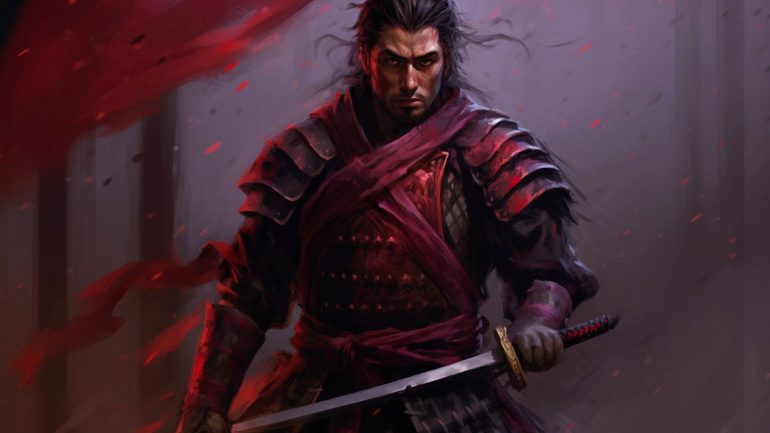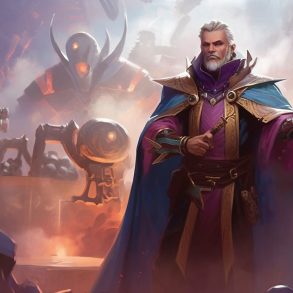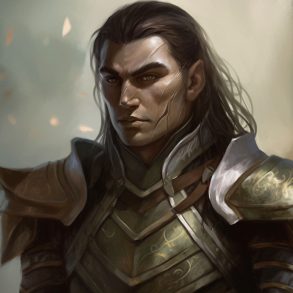An excellent subclass for those looking for simple but effective mechanics, or players looking to unleash the devastating power of advantage the Samurai appeals to many different players. One of the highlights is the balance between offensive might and defensive durability, which makes it very forgiving if you make a tactical error, or just get unlucky with the dice.
In this mini-guide, we’ll break down what this Martial Archetype provides you, as well as give you an insight on how to play this ferocious subclass.
More than Just a Katana: Samurai Features
Level Three
Bonus Proficiency – You can choose a skill proficiency from the following list: History, Insight, Performance, or Persuasion. If you do not want one of these skills, you may choose any language instead. This is a nice boost to your out of combat utility, if you don’t have Persuasion from your race or background then you should choose it with this feature. By doing so you will be able to leverage Elegant Courtier much more effectively.
Fighting Spirit – Three times per long rest you can use a bonus action to give yourself advantage on all weapon attacks you make that turn. You also gain a number of temporary hit points that increase as you gain more levels in this subclass: 5 temp HP at 3rd level, 10 at 10th level, and 15 at 15th level. The core feature of this subclass simultaneously increases your damage by improving your accuracy and increases your durability through the temp HP. This is most easily optimized by using the advantage to compensate for the -5 to hit penalty from Sharpshooter and Great Weapon Master.
Level Seven
Elegant Courtier – You gain proficiency in Wisdom saving throws, if you already have this proficiency then you can choose proficiency in either Intelligence or Charisma saves instead.
You can also add your Wisdom modifier to any Charisma (Persuasion) checks you make. This is a great feature as Wisdom saving throws will become increasingly more common from monsters beyond this level, with the effects of failure typically severe. The boost to your Persuasion checks allows you to hold yourself well in social situations.
Level Ten
Tireless Spirit – If you have no remaining uses of Fighting Spirit, you regain one use when you roll initiative. This is a quality of life improvement, allowing you to spend your uses of Fighting Spirit more freely.
Level Fifteen
Rapid Strike – Once per turn, when you take the Attack action and have advantage against a target, you can trade that advantage for an additional attack against that target as part of the same action. An excellent ability that allows you to turn any source of advantage into another attack, such as an enemy being prone, or having been hit with the Guiding Bolt spell. Something important to note with this ability is when using Fighting Spirit, you must give up advantage on one attack, but the attack you gain from this feature can still benefit from Fighting Spirit’s advantage.
Level Eighteen
Strength Before Death – Once per long rest when you take damage that reduces you to 0 HP, but doesn’t outright kill you, you can take a reaction to immediately take an extra turn before dropping unconscious, this interrupts the current turn. Taking damage during this extra turn causes failed death saves as normal, and three failed death saves can still kill you. You fall unconscious after this extra turn if you still have no hit points. Niche in its use, or at least it should be, if you’re dropping to 0 HP frequently there may be a problem! This suffers from its triggering condition but is a very potent boost to your damage-dealing for that round. Once this feature is available you should start saving your Second Wind, as you can use it on your extra turn to take yourself back up from 0 HP and not fall unconscious, temporary hit points from Fighting Initiate won’t save you.
Exemplary Bushido – Sample Builds
Death from the Shadows (Wood Elf Fighter 17/Ranger 3)
Here is a suggested Ability Score Array for this build using the point buy method, before applying racial ability score increases:
Str 10 Dex 15 Con 14 Int 8 Wis 13 Cha 12
The +2 Dex from being an elf will take your Dexterity to 17, which you will round out to 18 with Elven Accuracy early on, and the +1 from being a wood elf will round out your Wis to 14. Trance makes recovering your Fighting Spirit a little easier in inhospitable areas, whilst the faster movement speed from being a wood elf helps you keep your distance from monsters.
This build focuses on enhancing Fighting Spirit with the Elven Accuracy feat, using the resulting ‘super advantage’ to reliably land the +10 damage from Sharpshooter. In Tier 2 the Gloomstalker subclass will add an initiative improvement and additional attack every first round of combat. It also adds the ability to be invisible to creatures relying on darkvision, serving as a potentially valuable source of advantage to fuel the Elven Accuracy and Sharpshooter combination. You’ll be carrying a rapier to deal with melee threats in the event that you’re closed on, or the situation makes your longbow unviable.
Key Levels
1-4: For your Fighting Style take Archery and use your fourth level ASI to pick up the Elven Accuracy feat, rounding out your Dex to 18. Your standard routine here will just be shooting things with your longbow, using Fighting Spirit and Action Surge as needed to take down big enemies.
5-10: With Extra Attack the value of Fighting Spirit increases significantly and this will continue when you use your 6th level ASI to pick up Sharpshooter. This not only gives you the opportunity to add more damage but allows you to engage your targets more reliably. At 7th level you’ll switch to Ranger, picking up either Dueling style for switching to melee as needed or Defense to increase your AC. For the Ranger subclass, you’ll choose Gloomstalker, allowing you to add your Wisdom to your initiative and adding an additional attack to your first turn of combat. It’s generally advised to not use the power attack from Sharpshooter on this additional attack, as you risk not getting the extra d8 damage it brings. This additional attack is also doubled with Action Surge, allowing you to make 6 attacks in one turn from level 9 onwards!
11-15: You’ll gain an ASI at character level 11, which is best used to max your Dexterity for a whole host of benefits. During this selection of levels, you’ll gain Indomitable, your third attack, Tireless Spirit, and another ASI. The ASI can be used on anything that catches your attention, you may want to increase your Constitution if you find yourself running low on hit points despite your temporary supply. Once your third attack comes online you’ll be able to use Action Surge and Fighting Spirit for a staggering 8 longbow attacks at super advantage, with the option to use the Sharpshooter power attack on any or all of them.
16-20: The end of your career brings the shoring up of your defenses with a second and third use of Indomitable, and two more ASIs that can be spent on feats of your choice. Examples of good feats to take include Fey Touched for access to teleportation and Wood Elf Magic if no one in your party has access to Pass without Trace. The capstone of this build is a second use of Action Surge per short rest, which combined with Tireless Spirit means that you can unleash a torrent of super advantage attacks throughout the adventuring day. By using Rapid Strike, Action Surge, and Fighting Spirit you can make a staggering 9 attacks on the first turn of a combat.
Disciplined Vengeance (Half-Orc Fighter 15/Paladin 5)
Here is a suggested Ability Score Array for this build using the point buy method, before applying racial ability score increases:
Str 15 Dex 10 Con 13 Int 8 Wis 12 Cha 14
Your racial ASI will increase your Strength to 17 and round your Constitution out to 14, the former setting you up for a half feat at 4th level. Being a half-orc will allow you to leverage the increased number of critical hits that will undoubtedly follow making many attacks at advantage, whilst also helping increase your survivability.
The aim of this build is to leverage the advantage granted by Fighting Spirit to make hard-hitting Great Weapon Master hits, whilst giving you the tools to make the critical hits you will inevitably be making devastating to your enemies. You will also have the durability to take large amounts of punishment from your enemies. The addition of the Paladin levels gives you a nova tool with Divine Smite, the ability to heal yourself or allies, an additional source of advantage, and some spellcasting to round out your bag of tricks.
Key Levels
1-4: You should use a greataxe as your primary weapon, the d12 is more swingy than the 2d6 of a greatsword, but it will be more impactful for your Savage Attacks feature and Orcish Fury, the feat you’ll take at 4th level. Orcish Fury will bump your Strength to 18, add an attack to your Relentless Endurance, and give you your first taste of a ‘smite’ by allowing you to add your weapon damage die again once per short rest. For your Fighting Style choose Fighting Initiate, selecting Trip Attack as your maneuver. This not only gives you a damage burst once per short rest, it also gives you another source of advantage by making monsters prone. Play during these levels is straightforward, just hit things with your greataxe, using Action Surge and Fighting Spirit against tougher opponents as needed.
5-10: For levels 5 and 6 you’ll keep to Fighter, taking Great Weapon Master with the 6th level ASI. From there, you’ll switch over to Paladin for the rest of this level bracket. With your second Fighting Style you should choose Great Weapon Fighting, this will help protect you from disappointing damage rolls. Vengeance will be the Oath you choose, with Vow of Enmity giving you your third tool for advantage. With your Paladin spells you should prepare Divine Favor for more damage, Shield of Faith for an AC boost, and Cure Wounds for another healing option. The ASI you receive at character level 10 should be used to pick up Slasher, advancing your Str slightly whilst also giving you a control ability and adding even more value to your inevitable crits.
11-15: 11th level will be your final level of Paladin, the Extra Attack is sadly redundant but a 4th 1st level spell slot and the new 2nd level slots and spells are definitely worth it. You now have the option of giving yourself a summoned mount with Find Steed or bolstering the hit points of your party with Aid. During these levels, you’ll gain Elegant Courtier and Indomitable to bolster your defenses and an ASI, which you should use to pick up Heavy Armor Master. This will max your Strength and give you a damage reduction, most monsters don’t have magical weapon attacks, so even at this level, it should stretch your temp HP even further. Tireless Spirit means that you can now freely use Fighting Spirit in every combat without fear you’ll be caught without it later in the day.
16-20: The final chapter of your adventuring career shows considerable power growth, with your character gaining a 3rd attack, Rapid Strike, a third use of Indomitable, and two more ASIs. The ASIs are free to be used how you would like, potentially bumping your Constitution or grabbing the Lucky feat, for example. You could even take Martial Adept to gain a second Superiority Die and two more maneuvers!
We hope that you’ve found this article helpful and are you’re now prepared for attempting diplomacy with that evil king before resorting to arrow-mancy. If you’re interested in more Fighter help and information, then check out our Fighter 5E guide, or if you just enjoy reading about the game, then check out our how to play section. Until next time, may your fighting spirit be indomitable and your Second Wind be well-timed.






